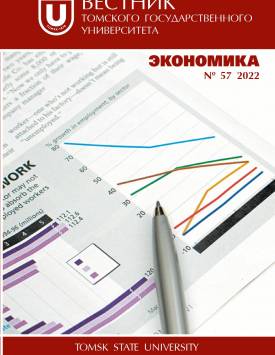The efficiency of the healthcare sector: Evidence from Mongolia
This research aims to investigate the efficiency level of Mongolia’s healthcare sector using statistical analysis. Based on previous research, the following three hypotheses are made: (i) The financing of the healthcare sector has no strong impact on healthcare sector efficiency; (ii) There is a statistically significant relation between the general indicators of the healthcare system; (iii) Compared to the healthcare systems of other countries that are based on unity, the operations of financial revenue collector and allocation organizations of Mongolia’s healthcare sector are inconsistent. In this research, the DEA method is used to determine the efficiency of Mongolia’s healthcare sector. The research results show that the efficiency rate of Mongolia’s healthcare sector is 94.55%, with the most influential factor being the number of doctors. The research determines the relation between 11 general indicators of the healthcare system. Total expenditure on healthcare as a percentage of GDP is not significantly related to the health sector’s general indicators. The health sector’s budget expenditure is insufficient. The analysis of the third hypothesis in the research shows no coherence in the activities of financial collector and allocation organizations of Mongolia’s healthcare sector. There is no independent accumulative entity and there is no unified system for allocating the multiple sources of funding. However, a comparative study on the healthcare systems of two countries, Kazakhstan and Bangladesh, shows that financial allocation done by a single organization is fundamental for increasing the efficiency of the healthcare sector. Therefore, a single buyer system is advised for Mongolia. Contribution of the authors: the authors contributed equally to this article. The authors declare no conflicts of interests.
Keywords
healthcare sector efficiency,
health care financing,
health insurance system,
data envelopment analysis,
life expectancy,
number of doctors,
hospital beds,
HALE,
infant mortality rateAuthors
| Damiran Suvdaa | National University of Mongolia | d.suvdaa@num.edu.mn |
| Dorjdagva Odbileg | National University of Mongolia | odbileg@num.edu.mn |
| Sukhbaatar Battulga | Mongolian National University of Medical Sciences | battulga@mnums.edu.mn |
Всего: 3
References
Health Development Center. (2019) Health indicators. Ulaanbaatar: Health Development Center. (In Mongolian).
Asandului, L. et al. (2014) The Efficiency of Healthcare Systems in Europe: A Data Envelopment Analysis Approach. Procedia Economics and Finance. 10. pp. 261-268. DOI: 10.1016/S2212-5671(14)00301-3
Audibert, M. et al. (2013) Health Insurance Reform and Efficiency of Township Hospitals in Rural China: An Analysis from Survey Data. China Economic Review. 27. pp. 326-338. DOI: 10.1016/j.chieco.2013.01.004
Audibert, M. et al. (2012) Health Insurance Reform and Efficiency of Township Hospitals in Rural China: An Analysis from Survey Data. 27 Apr. 2012. [Online] Available from: https://halshs.archives-ouvertes.fr/halshs-00587799 (Accessed: 15.01.2021).
Henderson, G. et al. (1995) Distribution of Medical Insurance in China. Social Science & Medicine. 41 (8). pp. 1119-1130. DOI: 10.1016/0277-9536(94)00420-X
Petitfour, L. (2017) Potential for Improvement of Efficiency in Health Systems : Three Empirical Studies. Universite Clermont Auvergne, 26 Sept. 2017. [Online] Available from: https://tel.archives-ouvertes.fr/tel-02081620 (Accessed: 20.01.2021).
Mozir Ahmetov, R.A. (2014) Uzbekistan health system review. UN: WHO Regional Office for Europe.
Keith, J. & Prior, D. (2014) Scale and Scope Economies in Mexican Private Medical Units. SaludPublica deMexico. 56 (4). pp. 348-354.
Farrell, M.J. (1957) The Measurement of Productive Efficiency. Journal of the Royal Statistical Society. Series A (General). 120 (3). pp. 253-290. DOI: 10.2307/2343100
Charnes, A. et al. (1978) Measuring the Efficiency of Decision Making Units. European Journal of Operational Research. 2 (6). pp. 429-444. DOI: 10.1016/0377-2217(78)90138-8
Bem, A. et al. (2014) Measurement of Health Care System Efficiency. Management Theory and Studies for Rural Business and Infrastructure Development. 36 (1). pp. 25-33. DOI: 10.15544/mts.2014.003
Asante, A.D. et al. (2014) Assessment of Equity in Healthcare Financing in Fiji and Timor-Leste: A Study Protocol. BMJ Open. 4 (12). p. e006806. DOI: 10.1136/bmjopen-2014-006806
Chimeddagva, D.B.C. (2017) Allocation and procurement of financial resources in the health sector. Ulaanbaatar: World Health Organization, Ministry of Health of Mongolia.
Gwatkin, D.R. et al. (eds) (2005) Reaching the Poor with Health, Nutrition, and Population Services: What Works, What Doesn’t, and Why. The World Bank.
Tradingeconomics.com. (2021) Mongolia Corruption Index | 1999-2020 Data | 2021-2023 Forecast | Historical | Chart. [Online] Available from: https://tradingeco-nomics.com/mongolia/corruption-index (Accessed: 01.03.2021).
Kutzin, J. et al. (2010) Lessons from Health Financing Reform in Central and Eastern Europe and the Former Soviet Union. Health Economics, Policy and Law. 5 (2). pp. 135-147. Cambridge University Press. DOI: 10.1017/S1744133110000010
Ministry of Finance. (2015) Goverment financial report. Ulaanbaatar: Ministry of Finance. [Online] Available from: https://s3.amazonaws.com/rgi-documents/752d6d35baee 7dd516dcd2311597ccb53ae2bafc.pdf (Accessed: 16.02.2021). (In Mongolian).
Suvdaa, D. (2019) Budget expenditure reform in Mongolia: Case in Health sector. Money&Finance. 2019. pp. 15-22. (In Mongolian).
Mongolia, G.O. (2005) Public Sector Strategic Management. Ulaanbaatar: ADB, MOF. (In Mongolian).
Langenbrunner, J. et al. (eds) (2009) Designing and Implementing Health Care Provider Payment Systems: How-to Manuals. World Bank. [Online] Available from: http://hdl.handle.net/10986/13806 (Accessed: 18.02.2021).
Erdene, S.D. (2007) Social insurance economics and reform issues. Ulaanbaatar: Admon. (In Mongolian).
Anwar, I. (2014) Health System in Bangladesh: Challenges and Opportunities. American Journal of Health Research. 2 (6). pp. 366-374. DOI: 10.11648/j.ajhr.20140206.18
Azaher Ali, M. & Chunhuei Chi. (2017) Who Pays for Healthcare in Bangladesh? An Analysis of Progressivity in Health Systems Financing.International Journal for Equity in Health. 16 (1). DOI: 10.1186/s12939-017-0654-3
Akhmetov, A. (2017) Testing the Presence of the Dutch Disease in Kazakhstan. 27 March 2017. [Online] Available from: https://mpra.ub.uni-muenchen.de/77936/(Accessed: 24.02.2021).
World Health Organization Regional Office for Europe et al. (2012) Kazakhstan: Health System Review. [Online] Available from: https://apps.who.int/iris/handle/10665/330319 (Accessed: 24.02.2021)

